Consensus Control of Multi-Agent Systems Using Fault-Estimation-in-the-Loop:Dynamic Event-Triggered Case
Yamei Ju, Derui Ding,, Xiao He,,Qing-Long Han,, and Guoliang Wei
Abstract—The paper develops a novel framework of consensus control with fault-estimation-in-the-loop for multi-agent systems(MASs) in the presence of faults. A dynamic event-triggered protocol (DETP) by adding an auxiliary variable is utilized to improve the utilization of communication resources. First, a novel estimator with a noise bias is put forward to estimate the existed fault and then a consensus controller with fault compensation(FC) is adopted to realize the demand of reliability and safety of addressed MASs. Subsequently, a novel consensus control framework with fault-estimation-in-the-loop is developed to achieve the predeterminedconsensusperformance withthel2-l ∞constraint by employingthevarianceanalysisand the Lyapunovstability approaches. Furthermore, the desired estimator and controller gains are obtained in light of the solution to an algebraic matrix equation and a linear matrix inequality in a recursive way,respectively. Finally, a simulation result is employed to verify the usefulness of the proposed design framework.
I. INTRODUCTION
IN the last decades, the collective behaviors (e.g., consensus and swarming) have been investigated toward multi-agent systems (MASs) due to their extensive implementation in engineering practice such as intelligent transportation systems,sensor networks, and formation control of unmanned air vehicles [1]–[3], and so forth on. As a typical representative,consensus is one of the emerging issues for MASs in the framework of cooperative control. The main goal of consensus, by utilizing local neighboring information, is to construct an appropriate control protocol such that the states of all agents reach some common values where each agent should be able to share its local information between adjacent agents via a shared communication network [4], [5]. To date,a surge of research results under different network environments or dynamic behaviors have been reported in the literature, including, but not limited to, linear MASs with network-induced phenomena or communication scheduling,nonlinear MASs with network-induced phenomena or communication scheduling, MASs subject to cyber-attacks as well as MASs with various constraints [6]–[8].
It should be noted that the interaction of data via the shared communication channels received a lot of attention primarily because of the spatial distribution characteristic of the agents.Compared with traditional networked control systems, the burden of communication has generally increased in practice and, consequently, the probability of data conflicts occurring has increased [9]–[11]. In order to overcome this shortage,some communication scheduling schemes, including eventtriggered protocols, stochastic communication protocols as well as Round-Robin protocols, have been employed to govern the exchanges of data, see e.g., [12]–[14] and the references therein. Among these protocols, considerable results based on event-triggered protocols have been devoted to deal with the consensus control issue, where data exchanges occur if and only if some predetermined events occur, see e.g.,[15]–[17]. This type of protocol is generally an artificially designed scheme for transmitting information into the application layer and thus its shapes and structures are diverse.It should be emphasised that event functions are usually constructed by real-time relative status/measurement information and fixed trigger thresholds. There is no doubt that these types of protocols lack the capacity to dynamically adjust the burden of communication. As such, from an engineering viewpoint, a dynamic event-triggered protocol(DETP) with time-varying threshold [18]–[21] should release much fewer events while still keeping the same system performance, which gives rise to one of the main motivations of our investigation.
It is not uncommon in engineering practice for system components to be subject to faults, which could result in degraded system performance or instability of the treated systems. As such, consideration must be given to the requirement of reliability and safety at the design stage. As an active approach, an adjustable controller can be predeterminately designed in the framework of fault tolerant control(FTC) such that the closed-loop system performance can be satisfied at an admissible level when unpredictable faults occur. For instance, a two-layer framework has been developed in [22] to realize the containment requirement in the presence of faults where the unknown fault coefficient has been estimated and an adaptive tracking controller has been derived. Furthermore, another novel approach should be that the appropriate compensation can be taken in active controllers where fault information (i.e., size and amplitude)can be provided via designed fault estimators. Obviously, the fault estimator will take part in the control closed loop, and hence this kind of approach can be regarded as active FTC using fault-estimation-in-the-loop [23]–[25]. To realize this purpose, the fault should be detected or estimated via observing the system input/output [26]. Nevertheless, most existing literature has been documented based on fault estimation or FTC problem only, see e.g., [27]–[32]. For instance, the states and fault signals have been estimated simultaneously in [27] with torus-event-based protocols and multiple fading measurements. Besides, a distributed FTC strategy has been obtained in [28] to ensure the overall stability for large-scale interconnected systems while the propagation characteristic of occurred faults cannot be taken into account adequately. In summary, the active FTC using fault-estimation-in-the-loop has not yet received much attention for the distributed system.
It is not difficult to find that a large body of accessible results have not been applicable to handle the consensus control issue of MASs with fault-estimation-in-the-loop, not to mention the case where a DETP is a concern. Evidently,consensus control embedded fault estimation for MASs under DETP inevitably encounters the following identified challenges: 1) how to design a consensus controller with fault compensation (FC); 2) how to develop an analysis framework of consensus performance considering the impact from faults;3) how to design the gains of both fault estimator and controller to realize the addressed consensus.
By the discussions above, this paper endeavours to develop a novel framework of consensus control with fault-estimationin-the-loop by addressing the above three challenges. The main contributions of this paper are highlighted as three aspects: 1) A novel cooperative framework of consensus control and fault estimation is established for MASs with DETP in the presence of faults; 2) A novel estimator with a noise bias is put forward to estimate the existed fault and then a consensus controller with FC is adopted to realize the desired consensus performance with thel2-l∞constraint; and 3) By employing the variance analysis and the Lyapunov stability approaches, the desired estimator and controller gains are obtained in light of the solution to an algebraic matrix equation and a linear matrix inequality in a recursive way,respectively.


A. System Models

II. PROBLEM FORMULATION AND PRELIMINARIES
The following assumption is imposed to achieve the main objective.
Assumption 1:The control matrix and the fault matrix satisfy rank(Bk,Fk)=rank(Bk), that is, there is a transform matrixMksuch thatFk=BkMk.
Remark 1:From the engineering point of view, part components of the actuator faults occur, which result in abnormal noises added in the normal control signals or the loss of normal control signals. As such, the assumption rank(Bk,Fk)=rank(Bk)is reasonable and of apparent significance in practice.
B. Fault Estimator and Controller Based on Dynamic Event-Triggered Scheme
In this subsection, a set of fault estimators will be designed to compensate the performance loss caused by faults in this paper. Specifically, an estimator on agentican collect all measurement signals from itself and its neighbours when needed and then estimates the potential faults with the purpose of FC. Furthermore, an event-triggered rule is exploited to adjust the communication burden. Now, let us provide more details about them.





A. Performance Analysis and Gain Design of the Fault Estimator
In this subsection, let us discuss the performance of the fault estimator and its gain design in the least-squares sense.Specifically, the upper bound of the estimator error covariance is presented and the estimator gain is designed to guarantee that such an upper bound is minimized.
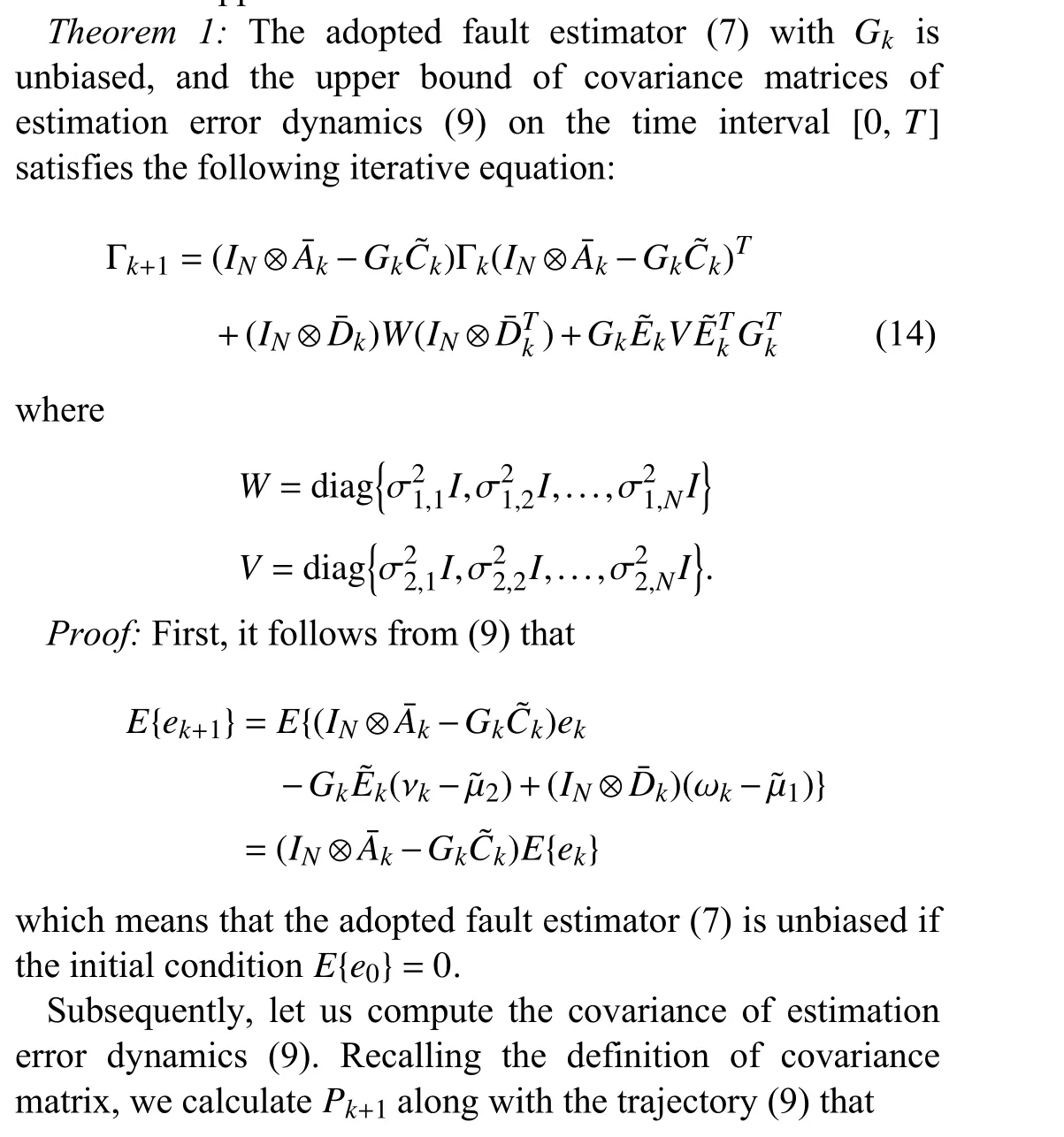
III. MAIN RESULTS

B. Controller Design With Fault Compensation
In the above subsection, the desired fault estimator is designed in the mean square sense. In what follows, a fault tolerant controller is discussed with the help of obtained estimated faults in this subsection.



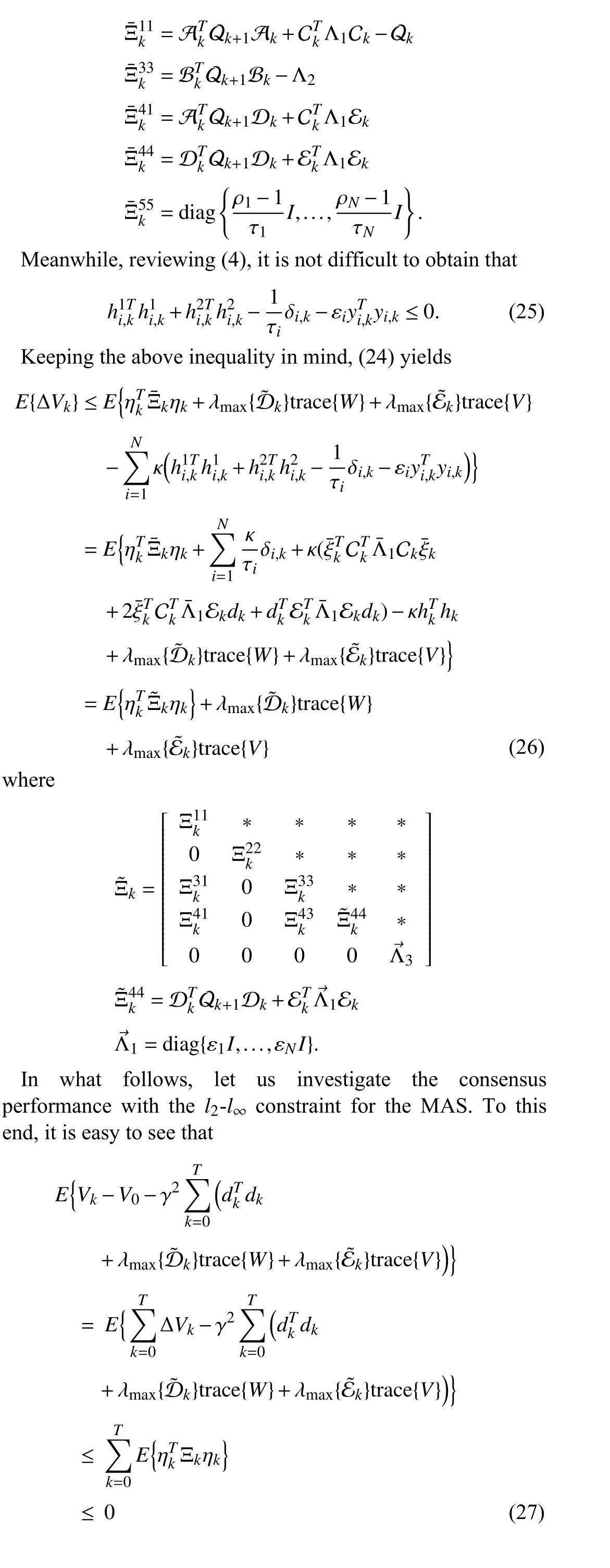
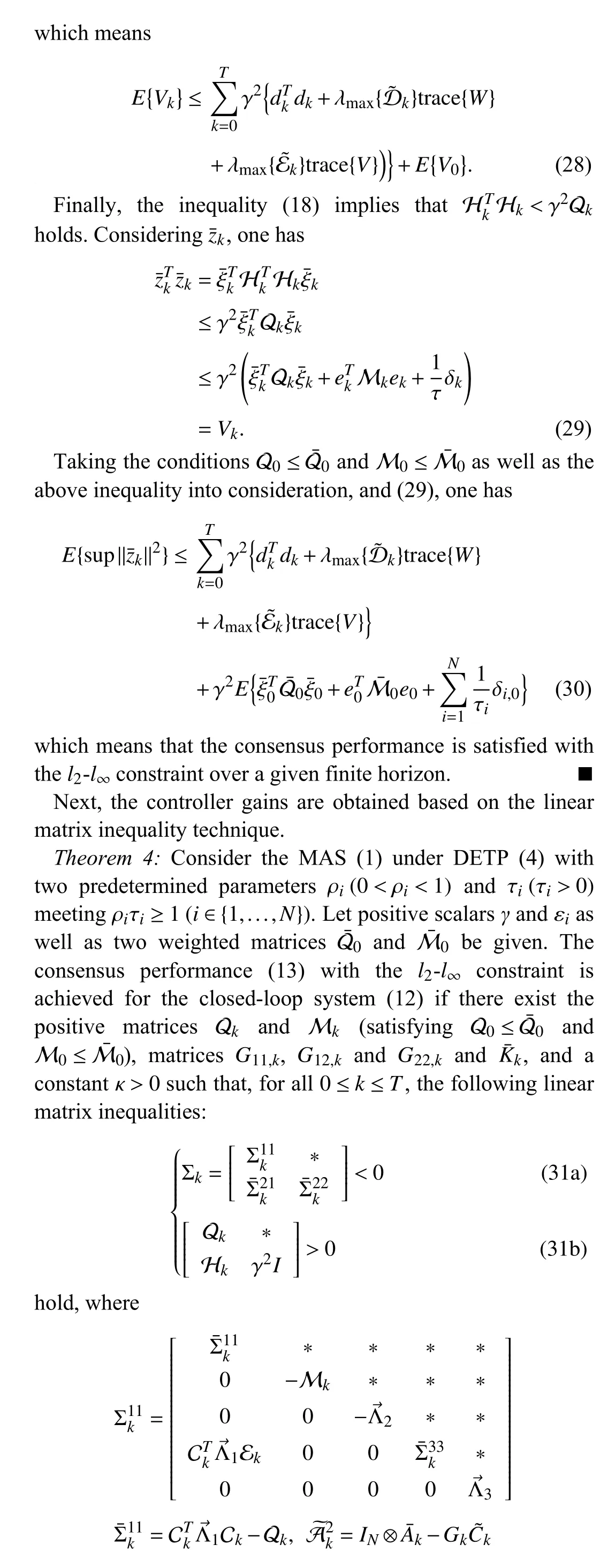


IV. SIMULATION RESULTS
In this section, a simulation example is executed to illustrate the validity of the presented method for the MAS (1) with DETP. Consider corresponding parameters with


Fig. 1. Communication topology among five agents.

V. CONCLUSIONS

Fig. 2. Actual fault and its estimation.

Fig. 3. The controlled output without FC and with FC.

Fig. 4. State trajectories xi1,k of five agents.
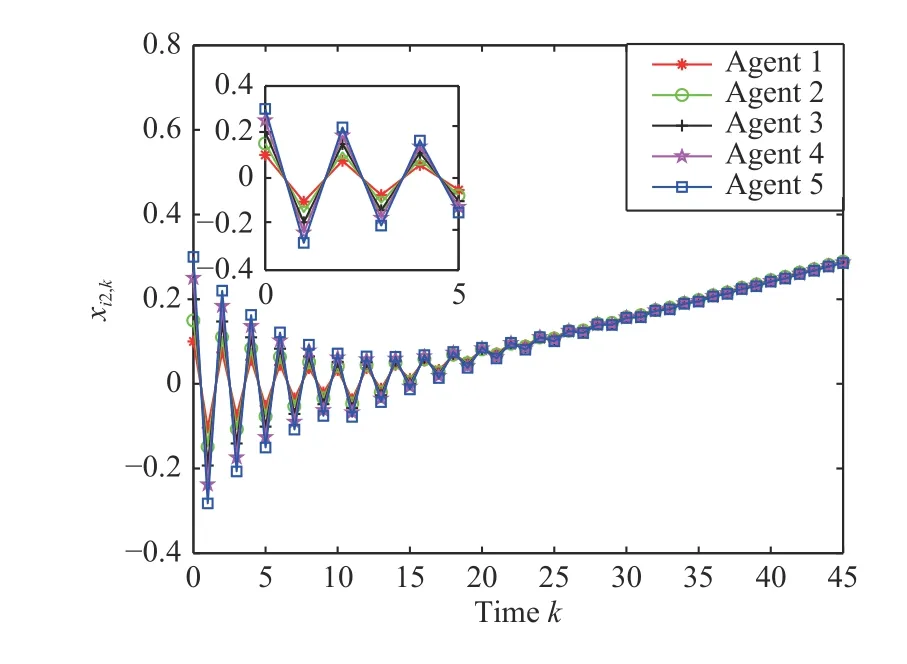
Fig. 5. State trajectories xi2,k of five agents.
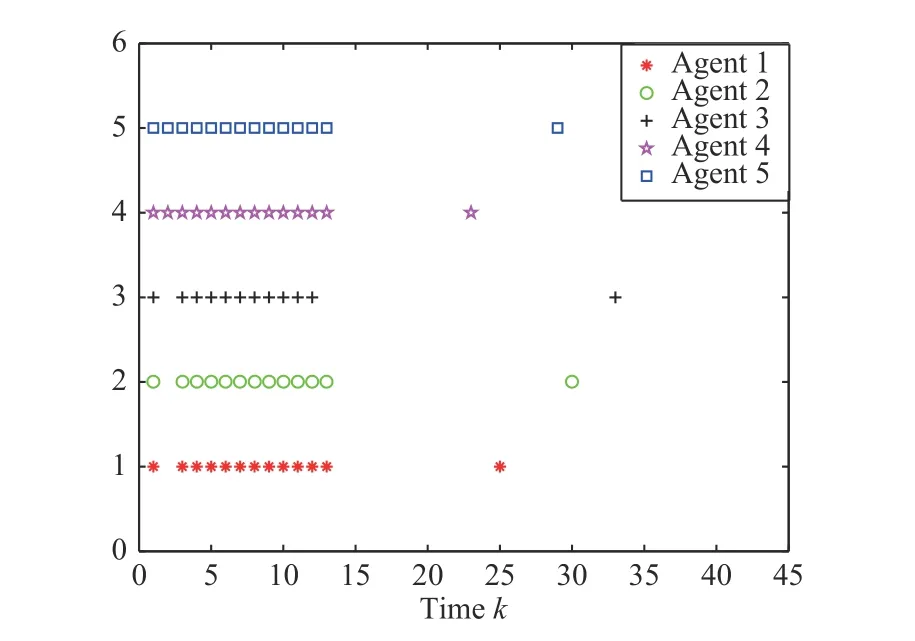
Fig. 6. Triggered instants of five agents.
The paper has proposed a novel consensus control framework with fault-estimation-in-the-loop for the MASs under DETP. For the sake of mitigating unnecessary data communications and improving the utilization of communication resources, DETP has been utilized by adding an auxiliary variable, where each agent transmits the measurement only when a predetermined triggering function is satisfied. Besides, according to utilizing the variance analysis and the Lyapunov stability approaches, the predetermined consensus performance with thel2-l∞constraint has been guaranteed. Furthermore, the desired estimator and controller gains have been obtained in light of the solution to an algebraic matrix equation and a linear matrix inequality in a recursive way, respectively. At last, a simulation result has been provided to verify the effectiveness of the proposed approach. Further research topics include the extension of our results to more general consensus issues with both communication protocols and cyber-attacks [34]–[36].
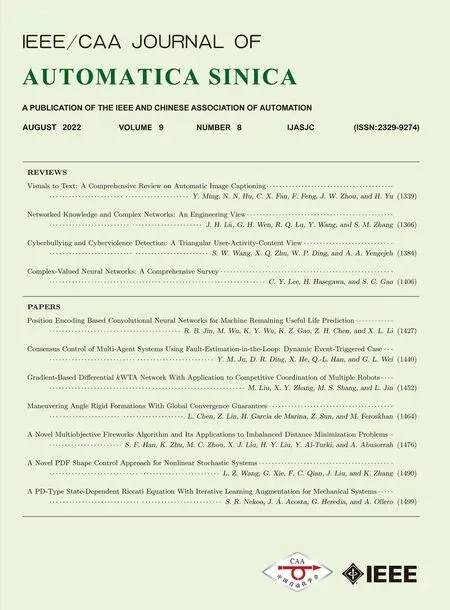 IEEE/CAA Journal of Automatica Sinica2022年8期
IEEE/CAA Journal of Automatica Sinica2022年8期
- IEEE/CAA Journal of Automatica Sinica的其它文章
- A PD-Type State-Dependent Riccati Equation With Iterative Learning Augmentation for Mechanical Systems
- Finite-Time Stabilization of Linear Systems With Input Constraints by Event-Triggered Control
- Exploring the Effectiveness of Gesture Interaction in Driver Assistance Systems via Virtual Reality
- Domain Adaptive Semantic Segmentation via Entropy-Ranking and Uncertain Learning-Based Self-Training
- Position Encoding Based Convolutional Neural Networks for Machine Remaining Useful Life Prediction
- Gradient-Based Differential kWTA Network With Application to Competitive Coordination of Multiple Robots
